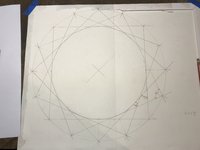55fireflite
New member
- Joined
- Feb 29, 2020
- Messages
- 2
Greetings,
I’ll start with my question: If I created a 16-sided polygon, with all sides and angles equal, that measures 13.5 inches across, how long will each side be?
Here why I’m asking:
I volunteer at a historic site that interprets life in Pennsylvania circa 1700. I’m working on woodworking project that has presented me with this geometry problem. Our blacksmiths are using a 21st century five-gallon plastic water bucket to quench their workpieces, which looks decidedly out of place in a 17th century blacksmith’s shop.
My task is to build a wood “bucket” (with no bottom) to slip over the plastic one, concealing it from view. I decided to use 16 staves, forming a 16-sided polygon. 360 degrees ÷ 16 = 22.5 degrees for each angle. Divide that by two, and each edge of each board needs to be beveled at 11.25 degrees. Using reclaimed white oak from the site, I milled the boards flat, cut the width oversize, and beveled one edge. Now I just need to know how wide the inside surface needs to be, and I can set the fence on table saw to cut the other edge.
I tried doing a full size layout, drawing a series of 8 overlapping squares, but I couldn’t get it accurate enough to get a precise measurement.
Thanks,
Tom
I’ll start with my question: If I created a 16-sided polygon, with all sides and angles equal, that measures 13.5 inches across, how long will each side be?
Here why I’m asking:
I volunteer at a historic site that interprets life in Pennsylvania circa 1700. I’m working on woodworking project that has presented me with this geometry problem. Our blacksmiths are using a 21st century five-gallon plastic water bucket to quench their workpieces, which looks decidedly out of place in a 17th century blacksmith’s shop.
My task is to build a wood “bucket” (with no bottom) to slip over the plastic one, concealing it from view. I decided to use 16 staves, forming a 16-sided polygon. 360 degrees ÷ 16 = 22.5 degrees for each angle. Divide that by two, and each edge of each board needs to be beveled at 11.25 degrees. Using reclaimed white oak from the site, I milled the boards flat, cut the width oversize, and beveled one edge. Now I just need to know how wide the inside surface needs to be, and I can set the fence on table saw to cut the other edge.
I tried doing a full size layout, drawing a series of 8 overlapping squares, but I couldn’t get it accurate enough to get a precise measurement.
Thanks,
Tom

